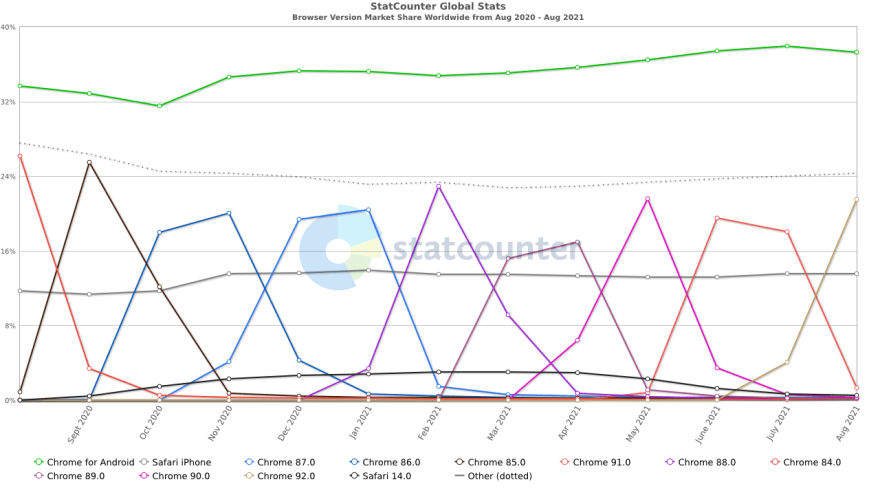Only people who are living under the rock aren’t using mobile phones for their daily activities. Well, this means we all rely on our phones for things such as booking tickets, consuming multimedia content, or even ordering groceries and medicine.
On average, most of us read, interact, engage and learn from the widely available resources like websites, mobile apps, etc. If we talk about just websites or web apps alone — Siteefy reports there are around 1,216,435,462 websites globally as of July 2021.
The same study states that about 10,500 websites go live every hour. As we speak, hundreds of new websites are being created. You get the drift — websites and web apps are as coveted as mobile apps.
PC: Meme Maker
Now, let’s discuss the essential facts — as of August 2021, the global browser market share report by StatCounter states that around 64.92% consume content via Google Chrome, followed by Safari at 18.43%. Another study on browser version market share by StatCounter shows that older browsers such as Chrome 85.0 and 86.0 are still in use.
We can observe that Samsung Internet 14.2 and Edge 92 are used by 2.03% to 3.36% of the world population. People access our website or app on different browsers and various devices. To ensure our site performs uniformly across multiple browsers, we perform cross-browser testing.
As the name suggests, cross-browser testing is a testing approach that ensures our website/app performs as intended across various devices and browser-OS combinations. It helps us validate the UI of our software.
PC: StatCounter
Usually, one of the most discussed possibilities while performing cross-browser testing is if we should move to a cloud-based testing tool. When we embrace the cloud, we perform end-to-end testing on the cloud itself.
It means we test, analyze, collaborate, and manage bugs from within the cloud. Cloud-based tools come with plenty of integrations, browsers, and real devices in their ecosystem that helps us accelerate our testing.
In this article, we’ll discuss 5 signs which mean that you should move to cross-browser testing on the cloud. Also, a related read that you might want to check out: when should you automate cross-browser testing?
5 Signs You Need to Choose Cross-Browser Testing on the Cloud
So, here’s the thing — we can either automate or perform manual testing to check out cross-browser compatibility. Let’s see the signs that we need to shift cross-browser testing to the cloud in manual and automated testing scenarios.
When should you move to the cloud for manual testing?
When you need to start cross-browser testing without delays of setting up or configuring
Configuring the environment is usually time-consuming because we need to maintain, upgrade, and update thousands of versions of browsers or real devices. Especially for running every test. However, when we move to the cloud, we can start testing quickly.
Cloud-based testing tools require no additional setup or configuration; they manage the testing environments, browsers, and device labs. Traditional tools demand a lot of time to get used to; with cloud-based tools, we can get familiar with the tool in less than a week. It’s best to go for a tool that handles training and onboarding so we can quickly learn.
PC: Testsigma
For instance, Testsigma, an automated cross-browser testing tool, doesn’t require any time for set-up. We can sign up and start using their tools from day one. Besides, it comes with comprehensive training and a knowledge base that helps in learning the tool.
When you need to start cross-browser testing without much investment in terms of cost
PC: Money vector created by pch.vector – www.freepik.com
It’s a known fact that if we setup all the infrastructure needed for cross-browser testing, we would need to invest in the maintenance and up-gradation of both old and new browsers as well.
With a cloud-based testing tool, we can eliminate this hassle. We can pick a cloud-based tool after factoring in our budgets, but it’s important to note that there is a higher ROI with cloud-based tools. Also, we pay for what we use, which makes it worth our effort.
Based on the project requirement, we can choose a testing tool that offers all the features we need to get started. Most cloud-based tools come with browsers and devices in their clouds; some tools even offer the earliest versions of Mozilla Firefox and Google Chrome.
When you want to pay only for the time you actually do the tests
PC: Money vector created by pch.vector – www.freepik.com
One of the biggest concerns with a traditional setup is that we still pay for its maintenance and infrastructure even when they’re not in use. Cloud-based tools offer a great solution to avoid excess costs.
A cloud is scalable, and we only have to pay for the time and features we use. Depending on our project requirement, we can scale up or down as cloud tools follow the pay-as-you-use or pay-per-usage concept, making them quite cost-effective.
Here is an exhaustive list of tools that can be used for cross-browser testing along with their salient features.
When should you move to the cloud for automated testing?
Cross-browser testing has become essential today but sometimes it has to be automated to get optimum results. Below we mention a couple of signs when you should automate your cross-browser testing.
When performing cross-browser testing is very time-consuming
PC: Calendar vector created by pikisuperstar – www.freepik.com
If it’s taking very long for our testers to perform cross-browser testing, thereby delaying our timelines and deliveries — it’s time to embrace the cloud. Cloud-based tools are designed for teams with agile and DevOps cultures, and these tools offer speed by expediting testing in several ways.
For instance, most cloud-based tools support reusing common test steps or shared functionalities across multiple browsers; we can effectively reduce the time and effort for test creation for multiple browsers.
When you also want to exercise the advantage of parallel test execution
For comprehensive cross-browser testing of our software, it’s vital to test it across various permutations and combinations of browsers and OS. If we’re running hundreds of tests, even though we’re automating, it can be time-consuming.
However, we can execute our tests in parallel in multiple environments with a cloud-based tool, thereby expediting our testing. Also, if we have to perform regression tests, we can automate them on the cloud. This ensures our testers focus their time on more important tasks rather than testing the same cases repeatedly.
Final words
By now, it’s clear that performing cross-browser testing on the cloud is beneficial, offers high ROI, and helps accelerate testing. With Testsigma, you can take your websites/apps to the next level. It’s a scriptless testing tool that comes with thousands of real devices and browsers for you to start testing right away.
It supports parallel test executions and CI/CD integrations. Besides, it allows testing apps on your actual devices locally with several browser-version configurations that Testsigma maintains for you.
PC: Testsigma
Here are more reasons why to choose Testsigma as your cross-browser testing solution














Latest comments (0)